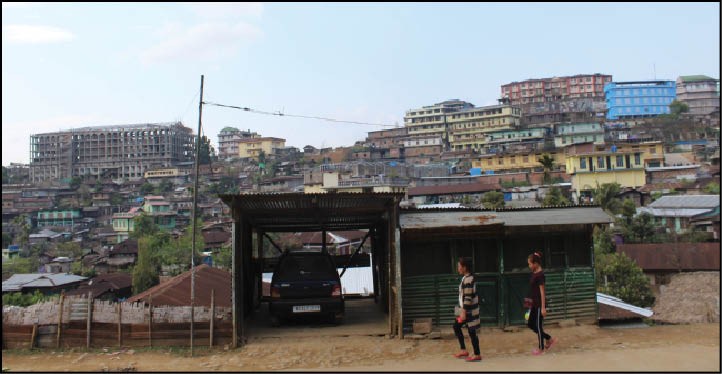Against the backdrop of high rise buildings, two women are seen walking along a road in a locality of Mon town which has been seeing rapid urbanization of late. (Morung Photo)

Ketholeno Neihu
Mon | April 22
Rapid urbanization is described as urban transformation taking place across regions and subsequently in the ever changing and developing world, change is inevitable.
A study undertaken by United Nations World Urbanization Prospects 2018 observed that “Urbanization has been faster in some less developed regions compared to historical trends than in the more developed regions.”
Mon town can be considered a case in point. This headquarter of Mon district, one of the remotest district from the Nagaland state capital, has long been considered as 'acutely underdeveloped.'
This perception appear to be changing as the town of late has been witnessing several transformation and rapid expansion coalescing in a mosaic of rural and urban setting.
Mon town, as per inputs from the Mon Town Council (MTC) has a geographical area of 2.1 square kms. There are altogether 11 wards.
An official of MTC interacting with The Morung Express said the town has been rapidly expanding (in terms of population), “thereby putting much pressure on land, due to manifold increase of rural-urban migration.”
As per MTC records, Mon town presently has a population of more than 28000. The 2011 census earlier recorded a total population of 16,590.
A police officer, who has been posted in the town since 2014, observed that traffic has certainly increased and this to him is of recent occurrence. “In less than a decade, the areas adjacent to the Police headquarter areas which had huge forest cover are now dominated with settlement.”
Data and analytics firm GlobalData predicts that better healthcare, education, commercial and standards of living drive people to the city.
Mon town, which is in close proximity to the state of Assam relies most of its commercial needs and healthcare services on this state.
With the spike in population, educational institutions are also thriving. “With more students coming to town for education, schools up to higher secondary level has become very competitive,” Atey Konyak , a student revealed.
Peter, a central government employee while reflecting on other services like banking pointed out that another branch of the State Bank of India opened just few years ago. Further, more ATMs in the town have eased saving and transaction especially for an employee like him.
Challenges
Inspite of the progress and changes taking place, logistics is a challenge because resources are tight.
The MTC official explained how town planning and developmental activities become difficult to implement when there is no resource.
Giving an instance, an initiative taken up by MTC where different wards were provided vehicles by the state government for waste disposal faces constraint because of the ‘issue of maintenance.’
Even as the town with its increasing population and expanding townscape struggle to catch up with the rest of the state, the town people is not happy with the government for its lackadaisical attitude and negligence.
“We have a very distinct land and a unique culture but we are still backward and considered that way by outsiders. The apathy of the government inspite of the public frequently pressing on issues is not helping in the growth and progress of the town,” Nyuwung, a church worker pointed out.
“Inadequate healthcare services, lack of higher education, and road link and inaccessibility are irksome and keeps us isolated from the rest of Nagaland,” he added.
Rural community and social affinities
One consequence of creeping urbanization is the dilution of culture, community lives or its existence.
Towards this, the community is confident that smart phone, high rise buildings or sleek cars is not going to create a rift with the rural community and its cultural mores.
“Although cars have increased, we still prefer to walk, or we cannot avoid serving a cup of strong black tea after every meal. These palpable sides of rural community and social affinities still live,” Amai, a school teacher attested.


